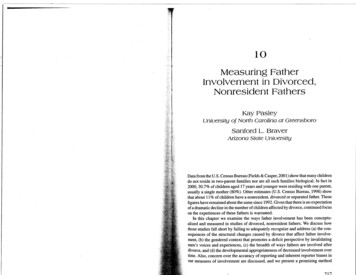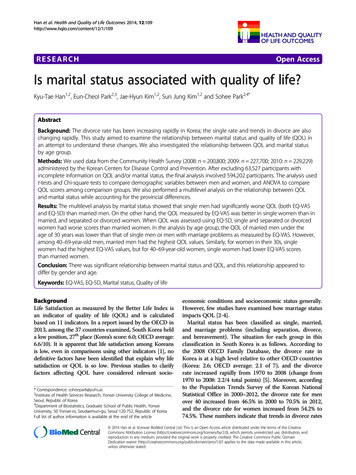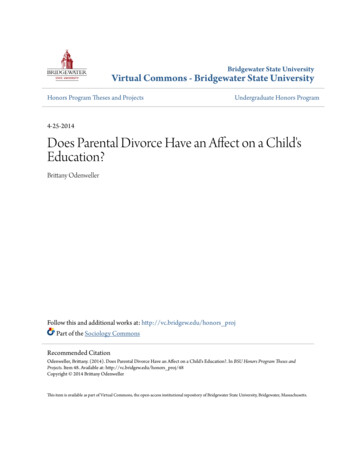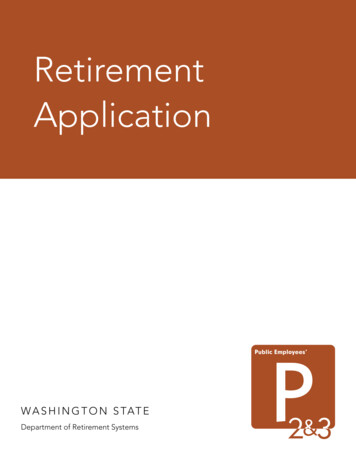
Transcription
10Measuring FatherInvolvement in Divorced,Nonresident FathersKay PasleyUniversity of North Carolina at GreensboroSanford L . BraverArizona State UniversityData from the U .S . Census Bureau (Fields & Casper, 2001) show that many childrendo not reside in two-parent families nor are all such families biological . In fact in2000, 30 .7% of children aged 17 years and younger were residing with one parent,usually a single mother (80%) . Other estimates (U .S . Census Bureau, 1998) showthat about 11 % of children have a nonresident, divorced or separated father . Thesefigures have remained about the same since 1992 . Given that there is no expectationof a dramatic decline in the number of children affected by divorce, continued focuson the experiences of these fathers is warranted .In this chapter we examine the ways father involvement has been conceptualized and measured in studies of divorced, nonresident fathers . We discuss howthose studies fall short by failing to adequately recognize and address (a) the consequences of the structural changes caused by divorce that affect father involvement, (b) the gendered context that promotes a deficit perspective by invalidatingmen's voices and experiences, (c) the breadth of ways fathers are involved afterdivorce, and (d) the developmental appropriateness of decreased involvement overtime. Also, concern over the accuracy of reporting and inherent reporter biases inour measures of involvement are discussed, and we present a promising method717
218PASLEY AND BRAVERof triangulating biases . We end the chapter by offering recommendations for addressing some of these limitations .MEASURES OF FATHER INVOLVEMENTEarly conceptualizations of father involvement for divorced fathers assumed thatfathers were either present or absent based on their marital status . Thus, marriedfathers were automatically considered to be present, and divorced fathers wereconsidered to be absent . (We see this in the early work on boundary ambiguityin families by Boss in 1977 .) Ahrons' (1981) study of coparenting in familiesof divorce was one of the first to assess parental involvement by questioningboth fathers and mothers ; she assumed that many divorced fathers, in fact, wereinvolved, and the important question was how frequently they were involved . Morerecently, the construct of father involvement in studies of nondivorced and divorcedfathers typically has been conceptualized as economic provision and other formsof behavioral involvements (Marsiglio, Amato, Day, & Lamb, 2000 ; Marsiglio,Day, & Lamb, 2000) with some recent scholarship on fathering also examiningthe motivations for involvement . We briefly describe some of the measures usedto assess these constructs . Studies are cited as examples only and are not meant tobe inclusive .Using economic provision as a measure of father involvement, scholars commonly ask divorced fathers and/or their former spouses about his payment orher receipt of child support and the amount of such payments "in the past year"(Berkman, 1986 ; Braver, Fitzpatrick, & Bay, 1991 ; King, 1994) . Other studiesquery respondents about the amount and regularity (on-timeness) of child support payments (Berkman, 1986), as well as contributions that do not include theexchange of money, such as the purchase of clothes, presents, dental care, andmedical insurance (Teachman, 1991) .Measures that assess other forms of behavioral involvement in studies of divorced fathers often use the same measures applied to studies of intact, twoparent families with a few exceptions . Typical indicators of father involvementinclude the frequency of participation in a series of activities (Ahrons, 1983 ;Aldous, Mulligan, & Bjarnason, 1998 ; Amato & Rivera, 1999 ; Bruce & Fox, 1999 ;Clarke-Stewart & Hayward, 1996 ; Guidubaldi, Duckworth, Perry, & Redmond,1999). Many of these activities reflect the constructs of engagement, accessibility,and social/emotional support, such as preparing meals, teaching a skill, attendingevents, doing household chores together, transporting to dental/medical appointments, discussing problems, being available for problems, and providing emotional support . Fewer studies include indicators of the cognitive domain ofbehavioral involvement, such as reasoning, planning, evaluating, and monitoring(Palkovitz, 1997) . Of these studies that have assessed the cognitive domain, theeffects of monitoring on child outcomes is the typical focus . No study was found10 .DIVORCED, NONRESIDENT FATHERS219that addressed other aspects of cognitive involvement, although there are dataavailable to assess planning (see report of the Federal Interagency Forum on Childand Family Statistics, 1998) . Even fewer studies include measures of the affectivedomain of behavioral involvement (e .g ., emotions, feelings, affection ; Amato &Rivera, 1999), although Palkovitz (1997) offered a strong rationale for its inclusionand other scholars agree (Marsiglio, Amato, et al ., 2000) . In fact, when affectiveinvolvement is measured, respondents are asked to report the quality of the fatherchild relationship often in terms of closeness/connection and perceived supportiveness (Amato & Rivera, 1999 ; Arditti & Keith, 1993 ; Barber, 1994 ; Buchanan,Maccoby, & Dombusch, 1996 ; Emery, 1999) .Measures of behavioral involvement unique to studies of divorced fathers included general assessments of the frequency, regularity, and duration of visits(face-to-face contact) and the frequency of phone calls, letters, and e-mail, usuallyreferencing behaviors within the past year or the past month (see as examples,Argys, Peters, Brooks-Gunn, & Smith, 1998 ; Beller & Graham, 1986 ; Buchananet al ., 1996) . Other measures include estimates of time, such as the number of weeksthe child visited or lived with the nonresident father (see studies using data fromthe National Survey of Families and Households, NSFH, 1998) or the percentageof time the child spent in the care of the father (Braver, Wolchik, Sandler, Fogas,Zvetina, 1991 ; Maccoby & Mnookin, 1992) . Still other measures attempted toassess the subjective nature of contact by asking about visitation quality (Arditti &Keith, 1993) .Marsiglio, Day, and Lamb (2000) suggest that the motives or perceptions associated with fathering are important to our understanding of men's behavior . To thisend, scholars have examined some of the motivations of divorced fathers . Studieshave assessed the effects of perceived competence, role salience, satisfaction,investment, employment status, and conditions of employment on involvement(Arendell, 1995 ; Fox & Bruce, 1999 ; Minton & Pasley, 1996a ; Futris & Pasley,1997). Other research has addressed the influence of the coparental relationshipon father involvement after divorce, particularly the ways in which mothers mayrestrict involvement (Arendell, 1995 ; Braver, Wolchik, et al ., 1991 ; Maccoby,1995 ; Minton & Pasley, 1996b) . However, most studies of coparenting focus onthe influence of the coparental relationship on child outcomes rather than on fatherinvolvement (Lamb, 1997 ; Hetherington & Stanley-Hagan, 1997) .HOW MEASURES OF INVOLVEMENTIN DIVORCED FATHERS FALL SHORTWe argue that the measures just described above and many of the measurementstrategies themselves are problematic for scholars seeking to understand fatherinvolvement in divorced, nonresident fathers . Next we outline these problems anc
220PASLEY AND BRAVERoffer some recommendations for reconceptualizing and measuring father involvement following parental divorce.Structural Changes Affecting InvolvementWhen divorce occurs, the pattern of family life is disrupted and new patterns mustbe negotiated and developed. Several issues relevant to the study of father involvement following divorce stem from these changes. For example, divorce means thatdecisions must be made regarding the care of dependent children, and such decisions translate into formal legal arrangements regarding the access parents haveto children (e.g ., legal and physical custody, visitation schedules) . Legal custodyconnotes which parent assumes the rights and responsibilities for making decisionsaffecting the health, education, and welfare of the child (Emery, 1994) . Thus, jointlegal custody arrangements continue the predivorce circumstance in which decisions affecting the child are shared by the parents . In contrast, sole legal custodymeans that only one parent is recognized legally to have this decision-making rightand responsibility. Physical custody is distinct from legal custody, as it indicateswho is going to provide care for the child on a daily basis . As such, great variationcan and does occurs in divorced families regarding the arrangement of physicalcustody. A common custody arrangement is the awarding of joint legal custodyin combination with primary physical custody to the mother, although the definition of primary physical custody can vary (Gunnoe & Braver, 2001 ; Maccoby &Mnookin, 1992) .The distinction between legal and physical custody is more complicated thanwould appear from our earlier comments, because evidence suggests that informal changes in both types of custody can and do occur, so the formal (de jure)award of custody does not necessarily reflect what happens in daily (defacto) life(Maccoby & Mnookin, 1992) . Consider a couple that is awarded joint legal custodywith primary physical custody to the mother . In one such couple, the father mayabdicate his decision-making responsibilities to his former wife, but they equallydivide the child's time so each parent provides half of the child's care . Anothercouple with this same custody arrangement finds the father highly involved in decisions, whereas the mother has most of the daily care of the child except duringvisitation with the father every other weekend .Two points are germane to our argument about the consequences of the structural changes imposed legally or informally on families after divorce . First, as aresult of divorce, most fathers simply do not have "at-will" access to their children,as they did prior to divorce . Although some custody arrangements are such thatfathers have more access and contact than others, in nearly all cases it is impossible to duplicate the earlier pattern of resident fathering, no matter how much theymight desire to do so . In reality, many fathers are relegated to a restricted visitation/access schedule, designated as every other weekend . Thus, when comparedwith nondivorced fathers, the structural barrier of the limited custody arrangementmeans that divorced fathers will appear less involved on most behavioral measures .10 .DIVORCED, NONRESIDENT FATHERS221In addition, family life on the weekends, when divorced fathers are most likelyto engage in face-to-face contact with children, is different than that during theweek. Weekends typically have less routinized patterns and activities, and thereis greater involvement in leisure pursuits . In contrast, behaviors such as planning (e.g ., making dental/medical appointments) occur during the week, when themother generally has responsibility for primary care . Applied to studies of fatherinvolvement, the nature and dynamics of the interaction during weekends wouldbe expected to be different from that of weekly daily involvement . Yet, we couldfind no study that examined involvement within this structural reality .Clarity of Referent . Many measures of involvement ask about the frequencyof participation in an activity from a series. Such measures often lack a specificanchoring to time, and other measures require respondents to report a specific timeframe (e.g ., within the past month, within the past year) . In either case, divorcedfathers, their former spouses, and, in some cases, their children may answer suchqueries using different referents . Some may refer to the frequency of what occursduring weekend visits ; others may consider frequency by comparing weekendswith fathers to weekends without fathers as the referent ; still others may refer tothe combination of weekdays and weekends regardless of where the child resides ateither time . Clear references to time allow us to make comparisons across groupsand provide greater assurance that the response of one participant is similar tothat of another . We could find no study that did this explicitly beyond the typicalreference to "in the past month" or "in the past year ."Boundary Issues . We argue that behavioral involvement is influenced by theovert boundaries established between parental households following divorce andthe accompanying behaviors of the parents and children . For example, the divorcedecree ordinarily spells out the "visitation privileges ." Whereas these privilegesvary considerably from family to family, the most common provision is one thatlimits contact to every other weekend . Thus, to visit more frequently could actually be a violation of the law . We could find no research that took this structurallimitation into account, although one way to do so is calculating "percentage compliance" for visitation (the amount of visits taking place divided by the amount ofcontact allowed by the decree or otherwise) .Regardless of what the decree says, a father's contact with his child could be virtually limitless, if the custodial mother permitted it to be so . She could easily-andwith no outside interference-permit him to visit more than their decree stipulated .This fact puts a focus on the behavior of the former spouse and the nature of thecoparental relationship in limiting father involvement . Both quantitative (Braver &O'Connell, 1998 ; Rettig, Leichtentritt, & Stanton, 1999) and qualitative data(Arendell, 1995 ; Pasley & Minton, 1997) reveal the negative side of "gatekeeping"and continued coparental conflict . In fact, some evidence shows that when fathersand their young adult children are asked, both wanted more contact than either themothers or the decree allowed (Fabricius & Hall, 2000) . Other evidence (Rettig
222PASLEY AND BRAVERet al., 1999) indicates the negative influence of continued conflict between formerspouses on father involvement . That is, many former wives encourage more contact between the father and his children than is outlined in any formal order, onlyto be disappointed when the father does not respond, although this pattern seemsless common than the reverse (Braver, Wolchik et al ., 1991 .) We would be remissif we failed to recognize that many fathers and mothers work hard to promoteand maintain a cooperative coparenting relationship and that the gate swings bothways (Walker & McGraw, 2000) . Important to our argument is that the potentialvariation in boundary maintenance means that measures of involvement should include indicators of court-ordered access, as well as desired and allowed access . Inthis way additional insight into the complexity of involvement by divorced fatherswould result .Mobility, Relocation, and Proximity . Another commonly occurring structural change after divorce involves mobility and relocation, which dramaticallyalter the pattern of family life. Researchers recognize geographic proximity as animportant variable affecting fathers' behaviors, and greater distance from a childis associated with less contact (Braver & O'Connell, 1998 ; Stewart, 1999). Forexample, Braver and O'Connell showed that 34% of mothers moved "more thanan hour's drive away from what used to be the family home," and in another 28%of families, the fathers moved (when both moved, these figures describe the parentwho moved first) . Thus, such relocations are normative and make face-to-face dailyinvolvement impossible, such that special handling of the resulting measurementissues is required.We note that proximity (distance) is used as a control variable in many studiesof divorced, nonresident fathers ; however, few attempts are made to tease out anydifferential effects of distance on various aspects of involvement (cf . Braver &O'Connell, 1998 .) All else being equal, fathers who have adequate resources cancontinue to have access to and involvement with children who live at a distancevia phone, e-mail, and letter writing, when distance and expenses prohibit face-toface contact. However, we could find no study that recognized the greater effortand expense required to maintain contact at a distance . This greater effort andexpense may undermine involvement, and inclusion of changes in location, distance, effort, and the associated expenses might better inform our understanding offather involvement. Because most nondivorced, resident fathers have ready accessdaily, less effort and expense is needed to maintain the father-child relationship .Divorced fathers who maintain contact in the face of relocation may represent aselect group-one that is both more responsible and resourceful and that possessesthe necessary economic resources . To date, scholars have done little to explore thenature and frequency of father involvement "from a distance ."Economic Provision. Divorce also results in heightened awareness of howthe provider aspects of father involvement influence the patterns of family life .Although nondivorced fathers have this responsibility also, their involvement in10 .DIVORCED, NONRESIDENT FATHERS223economic provisioning is taken for granted and commonly measured by their employment status and income . The legal context of divorce makes this responsibilityexplicit . Some variation across states regarding court orders for child support exists, and these differences result in higher or lower percentages of fathers beingordered to pay. For example, 83% of those in California were ordered to pay childsupport (Maccoby & Mnookin, 1992) ; 75% were ordered to do so in Wyoming(personal communication, Office of Family Services, December 2000) . Not onlyare there variations in whether fathers are ordered to pay, but there also are variations in how much they are ordered to pay (Emery, 1999 ; Pirog, Klotz & Byers,1998) . Morgan and Lino (1999) analyzed child support guidelines in every stateand found enormous variability . For an identical family size and parental incomescenario, a presumptive order varied from a low of 550 per month in Mississippi toa high of 1,054 in Nebraska . According to Venohr and Williams (1999), about halfthe states provide significant reductions based on the percentage of time fathersspend with children in determining the award, but, with two or three exceptions,only if that percentage is substantial (the "shared parenting adjustment") .For measurement purposes and in light of such variation, we believe that it isreasonable to divide the amount of child support paid by the amount of child supportordered to establish a "compliance ratio" instead of, or in addition to, simply askingabout the amount paid . Whereas some data sets ask about court orders/awards (seethe NSFH, 1998) and enable calculation of this ratio, other data sets do not includethis query (e .g ., ADD-Health, Udry, 1997) . Also, researchers who worked with adata set that had the information available failed to make these calculations (e .g .,King & Heard, 1999) .Additional complications arise because some fathers who are not ordered to paydo so anyway, informally and voluntarily (Argys et al ., 1996 ; Greene & Moore,1999) . Fabricius, Braver, and Deneau (2003) studied the financial support divorcedfathers provided for their young adult children's college expenses . Because thechildren were no longer minors, they were under no legal obligation to pay anything ; however, substantial support was provided, especially among fathers withjoint legal custody, who, after adjusting for differential income, provided proportionately more than did custodial mothers .Failure to differentiate the economic contributions made voluntarily from thosemade under court order erroneously treats all divorced fathers as a homogeneousgroup . How would our reporting change if the research questions were abouteconomic responsibility or compliance? If we included additional indicators ofeconomic involvement by measuring responsibility (court-ordered), amount, andregularity of child support payments, designating involvement would be even morecomplicated. Typical measures do not account for these complex variations amongdivorced, nonresident fathers and their experiences, although we believe thesemeasurement issues should be addressed .A related problem in asking about financial provision has to do with the interpretation respondents make of a query . Consider an item that asks about the timelinessof payments . A father who directly mails his payment to his former spouse by the
224PASLEY AND BRAVERdue date or has the payment automatically withdrawn from his paycheck and forwarded to a collection agency typically will report making his payment "on time ."Because it takes time for the payment to arrive (e.g ., the agency has to processthe payment or the mail system to deliver it), the former spouse may report thepayment as "late" because it is not received on the designated date . Other questionsmay ask about the regularity of payments (whether they are made "regularly"),and these also can be more or less problematic depending on the specificity of thequery. When questions allow respondents to define "regularity" for themselves,we cannot be confident that the query is interpreted in a similar fashion . Greatercare must be exercised in selecting terminology and clearly articulating questionsso more accurate reporting is possible .Gendered Context and the DeficitPerspective of Divorced FathersSome scholars acknowledge that divorce occurs in a context in which genderbias is enacted (e.g ., Arendell, 1995 ; Buehler, 1995 ; Braver & O'Connell, 1998 ;Maccoby & Mnookin, 1992 ; Pasley & Minton, 1997) . Fineman (1991) suggestedthat the presumption of gender neutrality and gender equality served as a guiding principle in many of the statutory reforms related to property division andspousal support, stemming from the view of marriage as a economic partnership .Buehler (1995) argued that contributions by husbands to family life occur primarily through employment and secondarily through household/family work, andthe reverse pattern is true for women . These primary and secondary role-relatedresponsibilities connote gender bias that influences the ways in which we conceptualise and measure father involvement . For example, early studies focused on thefinancial contributions fathers made in terms of child support, so interest was onamount, frequency, and regularity of such payments (Cassetty, 1978 ; Chambers,1979) . Often compliance was viewed as a reflection of father involvement, andmen have been disparaged for noncompliance as "deadbeat dads," although suchbeliefs have been effectively challenged (Braver & O'Connell, 1998) .The gendered presumption that men are economically responsible for familiesis apparent in research comparing the payment of child support by nonresidentmothers and nonresident fathers . Findings show that nonresident mothers are lesslikely to pay (Brown, 2000 ; Stewart, 1999), the amount is frequently less thanthat ordered of fathers with equivalent standards of living, and mothers pay lessregularly (e .g ., Meyer & Garasky, 1993) . However, we do not see the same negativelabels (e.g ., "deadbeat moms") applied to women who are noncompliant .Another area in which gender bias is evident is in custody decisions . Manyscholars (Buehler, 1995 ; Mason, 1994 ; Maccoby & Mnookin, 1992) note that,despite laws to the contrary, custody decisions are hardly gender neutral, andfigures indicate that about 85% of divorced nonresident parents are fathers (U .S .Census Bureau, 1998) . In this culture, parenting is conducted primarily by mothers,10 .DIVORCED, NONRESIDENT FATHERS225and most parents prefer and adopt this pattern of role responsibilities . Althoughonly one state (Minnesota) has a primary caretaker criterion as a formal part ofits custody statute (meaning custody should be awarded to the parent who servedas primary caretaker during the marriage ; Crippen, 1990), judges in most statesfrequently apply a primary caretaker preference anyway (Buehler, 1995 ; Emery,1994 ; Kelly & Lamb, 2000) . The result is gender biased, because men rarely fitthese criteria .Further, the gender bias is apparent in many of the commonly used measures offather involvement because most are derived from measures developed and usedprimarily with mothers as respondents, implicitly suggesting that fathers shoulddo what mothers do . As a result, most measures assess engagement activities ; thiskind of face-to-face contact, especially that which is instrumental in nature, is morecharacteristic of the types of behaviors mothers engage in than that of fathers, whoare more likely to be accessible and engage in recreational activities (Lamb, 1997) .Often there is little if any recognition of father's involvement in play activities withchildren, even though research shows this is a prominent way for fathers to spendtime with young children . Given the structural barriers to engagement for divorced,nonresident fathers, we believe that measures of accessibility must be furtherexplored, as accessibility is less affected by the structural changes that come withdivorce. For example, whereas physical accessibility is common in nondivorcedfamilies, accessibility by phone might be expected when fathers are not in closeproximity to the child as is the case in many divorced families . Also, becausemany fathers are restricted to having face-to-face contact with their children onweekends, we would do well to acknowledge that leisure activities commonlyoccur on weekends in most families, not just divorced families .Breadth of Father InvolvementAfter DivorceMuch of the empirical work has not addressed the structural constraints of thedivorced family context . Therefore, we have been unsuccessful in understandingthe full breadth of father involvement among divorced fathers, and more workis needed on measures that assess accessibility, responsibility, and the emotionaland cognitive domains of father involvement . We noted earlier that accessibility(and engagement) can and is restricted by the legal context, geographic proximity,and the nature and quality of the continuing coparenting relationship . Further, thechild's response to the structural changes resulting from parental divorce can anddoes affect his or her willingness to connect with the father (Maccoby & Mnookin,1992; Emery, 1999), and both mothers and fathers are known to limit accessbecause of what they believe is best for the child (e .g., Arendell, 1995 ; Wolchik,Fenaughty, & Braver, 1996 ; Pasley & Minton, 1997) . Yet measures typically donot account for children's responses or parental responses in light of children'sresponses.i
226PASLEY AND BRAVERMoreover, we believe that the typical measures of responsibility (e .g., paymentof child support, monitoring) inadequately address other dimensions of responsibility, such as protecting the child, meeting commitments (e .g., picking the childup on time, attending school-related activities), or teaching the child certain skills(e .g ., appropriate social behavior) . In fact, we know of no study of divorced,nonresident fathers that asked about their level of responsibility in a variety ofparenting activities typically asked of fathers and mothers in nondivorced families (see Pleck, 1997) . Thus, we do not know the answer to questions concerningwho and at what level a parent is responsible for certain aspects of parenting,under what conditions (such as divorce) this responsibility changes, and how itchanges .We also believe an important aspect of father involvement remains virtually unexplored : the cognitive domain (Palkovitz, 1997) . Research shows that divorcedfathers and mothers are highly concerned/worried about the possible effects thattheir decision to divorce can have on their children (Hetherington & Stanley-Hagan,1997 ; Kitson, 1992) . Findings suggest that they are cognizant of their children'sresponses to the divorce, and fathers comment that these concerns prompt them todisengage from their children (Braver & O'Connell, 1998 ; Futris & Pasley, 1997) .Buehler and Pasley (1993) argued that the cognitive or psychological presence ofthe child to the father is likely heightened after divorced . Although this construct(psychological presence) may provide a unique understanding of some cognitionsassociated with fathering after divorce from both the father's and the child's perspectives, it has yet to be studied adequately . Because psychological presencereflects concern and worry about one's child, fathers may choose to limit theirinvolvement in the hope that this reduces the children's stress (Arendell, 1995 ;Braver & Griffin, 2000 ; Futris & Pasley, 1997) . Interestingly, using data from theMinton and Pasley (1996a) study, we found that the level of psychological presenceof the child did not differ significantly between nondivorced, resident fathers anddivorced, nonresident fathers (Minton & Pasley, 1996b) . Thus, if psychologicalpresence had been used as one indication of father involvement, these data wouldhave shown that their level of this type of involvement is equivalent ; however, themeasure of engagement with this sample showed divorced, nonresident fathers asless involved .Developmental Appropriatenessof InvolvementAnother limitation is that most studies of fathering after divorce fail to considerthe developmental appropriateness of different kinds of involvement as the childmatures . For example, the often-cited study by Furstenberg, Peterson, Nord, andZill (1983) shows a dramatic decline in fathers' contact in the first 2 years afterdivorce . Less often noted is that these target children were 11-16 years of age,an age when children's focus turns to peers and when visitation interferes with10 .DIVORCED, NONRESIDENT FATHERS227children's
usually a single mother (80%). Other estimates (U.S. Census Bureau, 1998) show that about 11 % of children have a nonresident, divorced or separated father. These figures have remained about the same since 1992 . Given that there is no expectation of a dramatic decline in the number of children affected by divorce, continued focus










